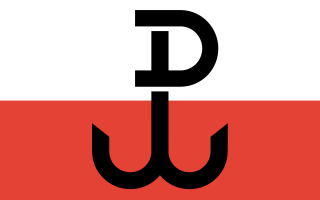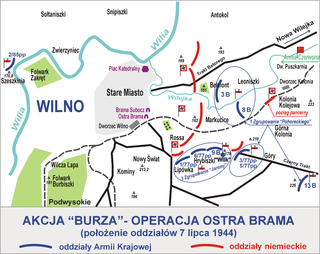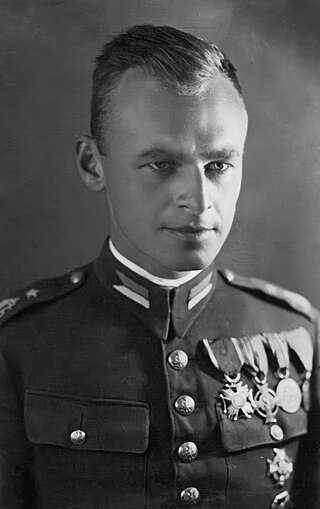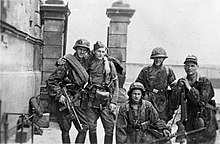
In World War Two, the Polish armed forces were the fourth largest Allied forces in Europe, after those of the Soviet Union, United States, and Britain. Poles made substantial contributions to the Allied effort throughout the war, fighting on land, sea, and in the air.

The Home Army was the dominant resistance movement in German-occupied Poland during World War II. The Home Army was formed in February 1942 from the earlier Związek Walki Zbrojnej established in the aftermath of the German and Soviet invasions in September 1939. Over the next two years, the Home Army absorbed most of the other Polish partisans and underground forces. Its allegiance was to the Polish government-in-exile in London, and it constituted the armed wing of what came to be known as the Polish Underground State. Estimates of the Home Army's 1944 strength range between 200,000 and 600,000. The latter number made the Home Army not only Poland's largest underground resistance movement but, along with Soviet and Yugoslav partisans, one of Europe's largest World War II underground movements.

The history of Poland from 1939 to 1945 encompasses primarily the period from the invasion of Poland by Nazi Germany and the Soviet Union to the end of World War II. Following the German–Soviet non-aggression pact, Poland was invaded by Nazi Germany on 1 September 1939 and by the Soviet Union on 17 September. The campaigns ended in early October with Germany and the Soviet Union dividing and annexing the whole of Poland. After the Axis attack on the Soviet Union in the summer of 1941, the entirety of Poland was occupied by Germany, which proceeded to advance its racial and genocidal policies across Poland.

Generał Tadeusz Komorowski, better known by the name Bór-Komorowski was a Polish military leader. He was appointed commander in chief a day before the capitulation of the Warsaw Uprising and following World War II, 32nd Prime Minister of Poland, 3rd Polish government-in-exile in London.

The Warsaw Uprising, shortly after the war also known as the August Uprising, was a major World War II operation by the Polish underground resistance to liberate Warsaw from German occupation. It occurred in the summer of 1944, and it was led by the Polish resistance Home Army. The uprising was timed to coincide with the retreat of the German forces from Poland ahead of the Soviet advance. While approaching the eastern suburbs of the city, the Red Army halted combat operations, enabling the Germans to regroup and defeat the Polish resistance and to destroy the city in retaliation. The Uprising was fought for 63 days with little outside support. It was the single largest military effort taken by any European resistance movement during World War II.

Stefan Paweł Rowecki was a Polish general, journalist and the leader of the Armia Krajowa. He was murdered by the Gestapo in prison on the personal order of Heinrich Himmler.

The Polish Workers' Party was a communist party in Poland from 1942 to 1948. It was founded as a reconstitution of the Communist Party of Poland (KPP) and merged with the Polish Socialist Party (PPS) in 1948 to form the Polish United Workers' Party (PZPR). From the end of World War II the PPR ruled Poland, with the Soviet Union exercising moderate influence. During the PPR years, the conspiratorial as well as legally permitted centers of opposition activity were largely eliminated, while a communist system was gradually established in the country.

The Polish government-in-exile, officially known as the Government of the Republic of Poland in exile, was the government in exile of Poland formed in the aftermath of the Invasion of Poland of September 1939, and the subsequent occupation of Poland by Germany, the Soviet Union, and the Slovak Republic, which brought to an end the Second Polish Republic.

Operation Ostra Brama was an attempt by the Polish Home Army to take over Vilnius from Nazi Germany's evacuating troops ahead of the approaching Soviet Vilnius Offensive. A part of a Polish national uprising, Operation Tempest, the action began on 7 July 1944 and lasted until 14 July 1944.

Operation Tempest was a series of uprisings conducted during World War II against occupying German forces by the Polish Home Army, the dominant force in the Polish resistance.

Witold Pilecki was a Polish World War II cavalry officer, intelligence agent, and resistance leader.

The Warsaw Uprising of 1944 was ended through a capitulation agreement which guaranteed not only the rights of the resistance to be treated as prisoners of war but also was designed to guarantee the fair treatment of the civilians living in Warsaw. This agreement, between General Tadeusz Bór-Komorowski and SS General Erich von dem Bach, had taken a long period of on-and-off negotiations to achieve.

The Warsaw Uprising, in 1944, ended in the capitulation of the city and its near total destruction by the German forces. According to many historians, a major cause of this was the almost complete lack of outside support and the late arrival of the support which did arrive. The only support operation which ran continuously for the duration of the Uprising were night supply drops by long-range planes of the Royal Air Force (RAF), other Commonwealth air forces, and especially units of the Polish Air Force (PAF), which had to use distant airfields in Italy and so had very limited effect.

The Silent Unseen were elite special-operations paratroopers of the Polish Army in exile, created in Great Britain during World War II to operate in occupied Poland.

The Polish Underground State was a single political and military entity formed by the union of resistance organizations in occupied Poland that were loyal to the Government of the Republic of Poland in exile in London. The first elements of the Underground State were established in the final days of the German and Soviet invasion of Poland, in late September 1939. The Underground State was perceived by supporters as a legal continuation of the pre-war Republic of Poland that waged an armed struggle against the country's occupying powers: Nazi Germany and the Soviet Union. The Underground State encompassed not only military resistance, one of the largest in the world, but also civilian structures, such as justice, education, culture and social services.

The Government Delegation for Poland was an agency of the Polish Government in Exile during World War II. It was the highest authority of the Polish Secret State in occupied Poland and was headed by the Government Delegate for Poland, a de facto deputy Polish Prime Minister.

The Lwów uprising was an armed insurrection by the Home Army underground forces of the Polish resistance movement in World War II against the Nazi German occupation of the city of Lviv in the latter stages of World War II. It began on 23 July 1944 as part of a secret plan to launch the countrywide all-national uprising codenamed Operation Tempest ahead of the Soviet advance on the Eastern Front. The Lwów uprising lasted until 27 July. Shortly afterwards, the Polish troops were disarmed, officers were arrested by the Soviet NKVD and ordinary soldiers either arrested or conscripted into the Soviet-created and controlled People’s Army of Poland (LWP) under Red Army command. Some were forced to join the Red Army, others sent to the Gulag camps. The city itself was occupied by the Soviet Union.

Michael Alfred Peszke was a Polish-American psychiatrist and historian of the Polish Armed Forces in World War II.

In Poland, the resistance movement during World War II was led by the Home Army. The Polish resistance is notable among others for disrupting German supply lines to the Eastern Front, and providing intelligence reports to the British intelligence agencies. It was a part of the Polish Underground State.

Aleksander Krzyżanowskinom de guerre "Wilk" was an artillery colonel of the Polish Army, officer of the Service for Poland's Victory, Union of Armed Struggle, commander of the Vilnius District of the Home Army, political prisoner of the Stalinist period. In 1994 he was posthumously promoted to the rank of brigade general.

















